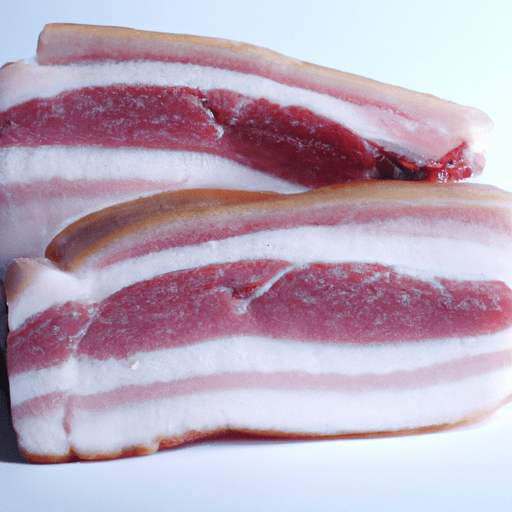Exploring the Richness of Pork Belly: A Culinary Delight
If you’re a fan of flavorful and succulent cuts of meat, then pork belly is a true delight for your taste buds. This cut, which comes from the underside of the pig, is beloved by chefs and food enthusiasts alike for its rich flavor and versatility in the kitchen. In this blog post, we’ll explore the wonders of pork belly - from its mouthwatering taste to its interesting history and nutritional value.
The Taste Sensation
A well-prepared pork belly has an incredible taste that will leave you craving for more. Its high ratio of fat to meat ensures a sumptuous and moist texture, while the layers of fat render during cooking, infusing the meat with an irresistible richness. The meat, when properly cooked, becomes tender and melt-in-your-mouth, with a combination of savory and slightly sweet flavors. Whether it’s roasted, braised, or grilled, the result is a flavor profile that is both sophisticated and deeply satisfying.
Culinary Uses
Pork belly is a versatile cut that can be used in a variety of culinary creations. One of the most popular dishes featuring pork belly is the famous Chinese dish, crispy pork belly. The skin is scored and then roasted, resulting in a crackling crunchy exterior, while the meat remains moist and succulent. These crispy pork belly slices can be enjoyed on their own or used as a topping for salads, noodle dishes, or even in sandwiches.
Braising is another excellent technique for pork belly. By simmering it in flavorful liquid over low heat for an extended period, the meat becomes incredibly tender and absorbs the surrounding flavors. This method is commonly used in dishes like braised pork belly with soy sauce or slow-cooked pork belly in a rich barbecue glaze. The possibilities are endless, and the result is always a dish that will impress your dinner guests.
Nutritional Value
Pork belly is a cut with a higher fat content compared to other parts of the pig. While this may deter some individuals, it’s important to note that fat can be a valuable source of energy and flavor. Additionally, pork belly offers essential nutrients such as protein, zinc, vitamin B12, and iron. As with any food, moderation is key when incorporating pork belly into your diet. By balancing it with a variety of vegetables and whole grains, you can enjoy this indulgence while maintaining a well-rounded eating plan.
A Bite of History and Additional Facts
Pork belly has a long and storied culinary history. It has been a staple in traditional cuisines from around the world, often revered for its ability to provide sustenance and flavor. In Italian cuisine, pork belly is used to make pancetta, a beloved cured meat that adds a salty and savory touch to pasta dishes and salads. In Korean cuisine, samgyeopsal, thinly sliced pork belly, is a popular meat for grilling, which is complemented by an array of flavorful condiments and accompanying wraps.
Interestingly, pork belly is also a key ingredient in the making of bacon. While bacon is typically made from pork belly that has been cured and smoked, it shares the same origin. The sumptuous aroma and crispy texture of bacon can be traced back to the delectable qualities of pork belly.
Conclusion
Pork belly is a culinary gem, boasting a delectable taste and a long history of being used in diverse cuisines worldwide. Whether roasted, braised, or used in beloved dishes like bacon, the succulent meat and luscious layers of fat make pork belly a joy to cook with. So, the next time you’re looking for a delicious and indulgent treat, consider exploring the wonders of pork belly - your taste buds will thank you!
Certainly! Here are some interesting facts about pork belly:
Origin: Pork belly is a cut of meat that comes from the belly of a pig. It is widely used and enjoyed in many cuisines around the world.
Common Uses: Pork belly is well-known for its use in traditional dishes such as bacon, pancetta, and Chinese-style pork belly. It is also used in various other preparations, including barbecue, stews, and braised dishes. Additionally, pork belly is often cured or smoked to enhance its flavor.
Nutritional Benefits: Pork belly is a rich source of protein, essential vitamins, and minerals. It provides significant amounts of thiamine, vitamin B12, zinc, and selenium. However, it is important to note that pork belly is also high in fat, particularly saturated fat, so it should be consumed in moderation as part of a balanced diet.
Unique Properties: Pork belly is known for its succulent and tender texture, as well as its ability to absorb flavors during cooking. The high fat content within the meat helps to keep it moist and adds a rich, indulgent flavor.
Historical Significance: Pork belly has a long history in culinary traditions. In Asian cuisines, such as Chinese and Korean, pork belly has been a staple ingredient for centuries. In Western cultures, it is famous for its role in classic dishes like bacon and English roast pork belly.
Remember to always handle and cook pork safely by following proper food safety guidelines, such as cooking it to the recommended internal temperature.




Use the share button below if you liked it.
It makes me smile, when I see it.